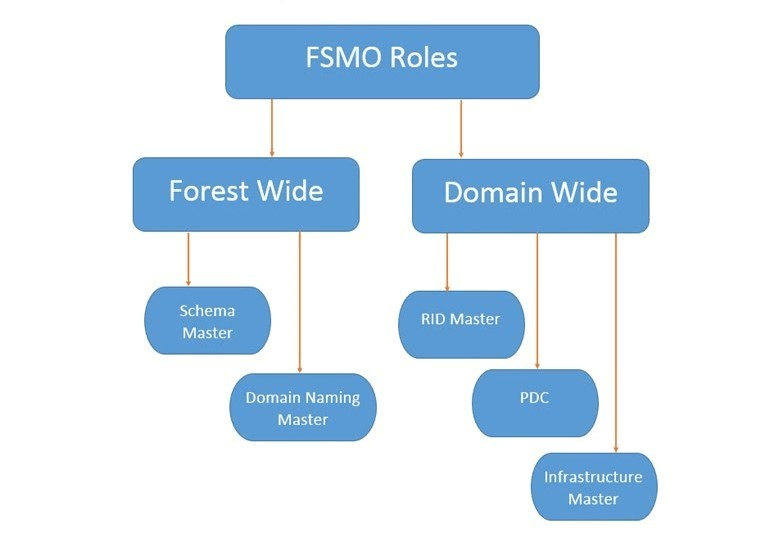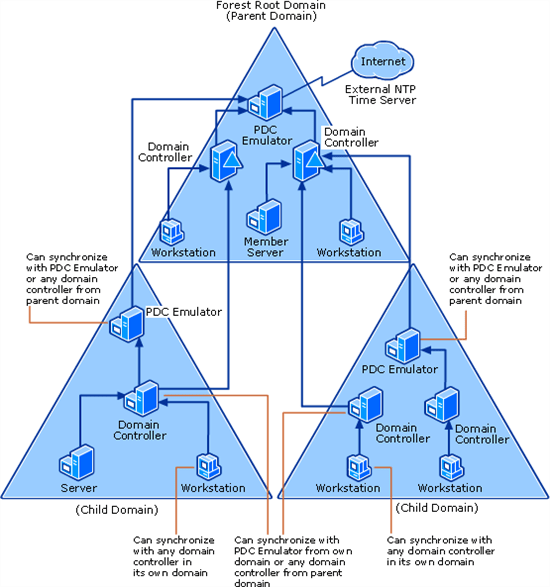
- Introduction to FSMO Roles in Active Directory
- What Are FSMO Roles?
- Overview of the 5 FSMO Roles
- How FSMO Roles Work in Active Directory
- Assigning and Transferring FSMO Roles
- FSMO Role Best Practices for AD Administrators
- Troubleshooting FSMO Role Issues
- Common Misconceptions About FSMO Roles.
- Conclusion
In Microsoft networking, Active Directory (AD) can refer to a centralized directory service that allows organizations and teams involved in networking and computing to control users’ groups, devices, etc. Part of its strategic infrastructure, AD mainly depends on several specialized FSMO roles responsible for retaining the integrity of its database. These roles are crucial in allowing an Active Directory environment to function smoothly because particular operations need to be carried out without causing a problem or conflict. In Cybersecurity Training Courses this comprehensive 2024 guide, we will explore FSMO roles in Active Directory, their significance, how they function, and best practices for managing and troubleshooting them. Whether you’re a beginner in Active Directory or looking to deepen your knowledge, this guide will provide valuable insights into mastering FSMO roles.
Are You Interested in Learning More About Cybersecurity? Sign Up For Our Cyber Security Online Training Today!
Introduction to FSMO Roles in Active Directory
FSMO (Flexible Single Master Operation) roles in Active Directory are specialized tasks assigned to specific domain controllers to prevent conflicts and ensure smooth operations in a multi-DC Sandbox Environment. There are five FSMO roles, divided into forest-wide (Schema Master and Domain Naming Master) and domain-wide (RID Master, PDC Emulator, and Infrastructure Master) roles. These roles handle critical functions such as schema updates, domain management, object creation, authentication, and cross-domain references, ensuring consistency and stability within the Active Directory infrastructure.
What Are FSMO Roles?
FSMO roles are specific roles assigned to Active Directory Domain Controllers (DCs). They ensure Active Directory data’s consistency, integrity, and availability across an organization’s network. There are five FSMO roles in total, divided into two categories: Forest-wide roles: These roles are needed for the proper functioning of the entire AD forest. Domain-wide roles: These roles apply within a particular domain. FSMO roles are important because they prevent conflicts and duplication of work that may result from multiple Top-CISSP Domains controllers trying to manage the same data. Without these roles, Active Directory would face problems such as replication conflicts, invalid schema updates, and authentication failures.
Overview of the 5 FSMO Roles
There are five FSMO roles, each serving a distinct function within Active Directory. Below is a breakdown of the five FSMO roles and their key responsibilities:
- Schema Master (Forest-wide): The Schema Master role updates the AD schema, which defines the structure of the Active Directory database and includes object classes, attributes, and the relationship between objects. When an update to the schema is required, for example, when adding a new attribute to user accounts, the Schema Master is the only domain controller that can accept and replicate these changes throughout the forest.
- Location: There is only one Schema Master in an Active Directory forest. Roles: Is in charge of schema changes. Coordinates the schema update process when promoting a domain controller.
- Domain Naming Master (Forest-wide): The role of the Domain Naming Master is to make sure that the names of the domains are unique within an Active Directory forest. This role also involves adding or deleting domains within the forest. This will not allow duplicate domain names.
- Location: There is only one Domain Naming Master in an Active Directory forest. Roles :It controls the creation and deletion of domains. It ensures that the domain names are unique in the forest.
- PDC Emulator (Domain-wide): The PDC Emulator role is the primary domain controller for backward compatibility with older Windows versions, such as Windows NT. It also deals with password changes, time synchronization between domain controllers, and administrative task processing.
- Location: There is one PDC Emulator per domain. Responsibilities :Handles password changes and login authentication. Acts as the authoritative time source for the domain. Manages group policy updates. Ensures backward compatibility for legacy applications.
Sign up for ACTE Cyber Security Online Training and get a head start in your career cyber security.

- RID Master (Domain-wide): The RID Master role allocates Relative Identifiers (RIDs) to domain controllers. RIDs generate new objects, such as user accounts and groups; thus, RID Master helps ensure that every RID allocated to the domain is unique for the domain controller.
- Location: There is one RID Master per domain. Job descriptions: Allocates RID to domain controllers Ensures the uniqueness of Information Security identifiers.
- Infrastructure Master (Domain-wide): The Infrastructure Master’s function is to update references of objects in other domains. For instance, if an object in Domain A refers to another object in Domain B, the Infrastructure Master will ensure that the reference is consistent between the domains. The Infrastructure Master is responsible for updating cross-domain object references.
- Location: One Infrastructure Master per domain Responsibilities: Updates the references of objects in other domains.Ensures that there is proper Replication of object references.
How FSMO Roles Work in Active Directory
FSMO roles are spread across domain controllers in the Active Directory infrastructure to ensure that the load is well-balanced and there are no conflicts. Most of the roles are domain-specific, but the Schema Master and Domain Naming Master roles are forest-wide, meaning that they apply to the whole AD forest and are only available on a single domain controller. Each FSMO role is typically placed on a domain controller assigned to a task. Although it is not impossible to transfer or seize FSMO roles between different domain controllers, best practices usually recommend putting the roles on stable and reliable domain controllers to reduce complexity. FSMOs are designed to work collectively to maintain the overall functionality of the Active Directory. Schema Master The schema master FSMO is responsible for ensuring schema integrity in this Cybersecurity Training Courses . Domain Naming Master controls the addition and removal of domains. PDC Emulator controls the change of passwords and the synchronization of time. RID Master assigns RIDs to domain controllers. Infrastructure Master controls cross-domain references.
To Earn Your Cyber Security Certification, Gain Insights From Leading Cyber Security Experts And Advance Your Career With ACTE’s Cyber Security Online Training Today!
Assigning and Transferring FSMO Roles
There are two main actions when managing FSMO roles: assigning and transferring roles. These are typically done during domain controller promotion but can also be done later for load balancing or fault tolerance purposes.
- Assigning FSMO Roles: When the initial Active Directory setup is made, FSMO roles are automatically assigned to the first domain controller in the forest. You can assign different roles to various Domain Name System controllers, but it has to be done based on requirements. This can be achieved by using ADUC or NTDSUtil.
- Transfer of FSMO Roles: The recommended way of transferring FSMO roles from one domain controller to another is to transfer. The methods involved are as follows:
- Graphical User Interface (GUI): Tools to use are Active Directory Users and Computers (ADUC) or Active Directory Sites and Services.
- Command Line Tools: NTDSUtil, PowerShell, or WScript The best practice in moving FSMO roles would not cause much of an inconvenience in the environment
- Taking over FSMO Roles: When a domain controller holding an FSMO role fails, you must seize the role to transfer the responsibility to another domain controller. Seizing a role should be done cautiously because it may lead to data inconsistencies or conflicts. You can seize a role using NTDSUtil.
FSMO Role Best Practices for AD Administrators
Limit the number of FSMO role holders Ideally, FSMO roles should not be spread across too many domain controllers to avoid unnecessary complexity. For stability and reliability, limiting the number of FSMO role-holders in the domain is best. Use reliable Domain Controllers Put FSMO roles on high-availability domain controllers that possess sufficient hardware resources to manage the responsibilities properly.

Preparing for a job Interview? Check out our blog on Cybersecurity Interview Questions and Answers !
Troubleshooting FSMO Role Issues
FSMO role issues can lead to serious Active Directory problems, such as authentication failures, replication issues, and schema inconsistencies. Common symptoms of FSMO role problems include: Inability to add or remove domains Replication failures Password Authentication change issues Access control problems
How to Troubleshoot FSMO Role Issues:- Check FSMO role availability: Use the command Netdom query FSMO or PowerShell to verify which domain controllers hold FSMO roles.
- Check Replication: Ensure domain controllers are replicating appropriately using tools like repadmin.
- Resolve time synchronization issues: Ensure all the domain controllers are synchronized from a reliable time source. Seize FSMO roles if necessary. When a domain controller has an FSMO role but is permanently offline, you should seize the role so that business continues.
Common Misconceptions About FSMO Roles
There are many misconceptions about the FSMO roles that people tend to make, confusing them or making mistakes whenever they try to manage their Active One FSMO role per domain Most FSMO roles are domain-specific except the Schema Master and Domain Naming Master, which are forest-wide. FSMO roles are automatically transferred. FSMO roles do not automatically transfer; the administrator must manually transfer them. Seizing FSMO roles is easy, but it should be carried out cautiously because Replication can be affected if carried out improperly.
Conclusion
To successfully implement the network infrastructure, it’s essential to master FSMO roles in Active Directory. Cybersecurity Training roles ensure the Active Directory runs smoothly and consistently across domains and the entire forest. From this understanding of how FSMO roles work, based on best practices, with effective troubleshooting of role-related issues, administrators can rest assured that their Active Directory environment remains healthy and secure. As the Active Directory environment continues to grow and evolve, this knowledge about FSMO roles and their management will always be critical for IT professionals in 2024 and beyond.





